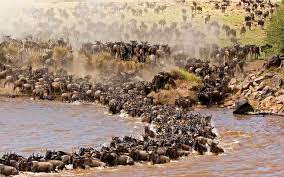Activities and attractions in Masai Mara Reserve
Activities and attractions in Masai Mara Reserve , Maasai Mara Reserve, also known as the Maasai Mara National Reserve, is one of the most popular tourist destinations in Kenya. Here are some of the top activities and attractions in Maasai Mara:
Game Drives:
Maasai Mara is renowned for its game drives, where you can see a diverse range of wildlife, including lions, cheetahs, elephants, giraffes, zebras, and many more. You can go on a morning, afternoon, or evening game drive with an experienced guide who will help you spot the animals and provide insights about them.
Hot Air Balloon Safaris:
A hot air balloon safari over the Maasai Mara is a unique and unforgettable experience. You can watch the sunrise and the wildlife from above and get a panoramic view of the reserve.
Maasai Culture:
Maasai Mara is home to the Maasai tribe, one of the most famous and respected tribes in East Africa. You can visit their villages, learn about their traditions, and even join in their dances.
River Mara:
The Mara River is a beautiful and important part of the reserve. It is home to crocodiles and hippos and is an important water source for the animals in the reserve. You can take a boat safari on the river and see the wildlife from a different perspective.
Birdwatching:
Maasai Mara is also a paradise for birdwatchers. There are over 450 bird species in the reserve, including the famous Secretary Bird, the Lilac-breasted Roller, and the Crowned Crane.
Walking Safaris:
If you want a more intimate and immersive experience, you can go on a walking safari with an experienced guide. You can explore the reserve on foot, learn about the flora and fauna, and experience the thrill of being up close to the wildlife.
Photography: Maasai Mara is a photographer’s dream destination. The stunning landscapes, the wildlife, and the Maasai people offer endless opportunities for photography.
Overall, Maasai Mara is a must-visit destination for anyone interested in wildlife, culture, and adventure.
Best months to visit Masai Mara Reserve
The best time to visit the Maasai Mara Reserve in Kenya depends on your interests and preferences. Here are some general guidelines to help you plan your trip:

Great Wildebeest Migration: If you want to witness the great wildebeest migration, the best time to visit is between July and October. During this period, millions of wildebeest, zebras, and gazelles migrate from Tanzania’s Serengeti to Kenya’s Maasai Mara in search of greener pastures. This is a spectacular sight to see, but keep in mind that this is also the busiest time of the year, and prices for accommodations and tours may be higher.
Wildlife Viewing: The dry season (from June to October) is the best time for wildlife viewing as the animals gather around water sources, making them easier to spot. The weather is also cooler during this period, which makes it more comfortable to go on game drives and walking safaris.
Bird watching: The best time for birdwatching in the Maasai Mara is from November to April when the migratory birds are present in the reserve.
Budget: If you’re on a tight budget, the low season (from April to June) is the best time to visit as prices for accommodations and tours are lower.
Weather: The Maasai Mara has a mild climate throughout the year, but the best weather is from June to October when it’s drier and cooler. The rainy season is from November to May, and it can make travel more challenging, but it also brings lush green vegetation and an abundance of wildlife.
In summary, the best time to visit Maasai Mara depends on what you want to see and do, your budget, and your weather preferences.
What happens during the Wildebeest Migration?
The wildebeest migration is one of the most spectacular wildlife events in the world, and it’s an incredible sight to see. Here’s what happens during the wildebeest migration:
Movement: Millions of wildebeest, zebras, and gazelles move across the plains of the Serengeti in Tanzania and the Maasai Mara in Kenya in search of food and water. The animals move in a circular pattern, following the rainfall patterns and the growth of grass.
River crossings: One of the most exciting parts of the migration is when the animals cross the Mara River. This is a dangerous and challenging part of the journey, as the animals must navigate through crocodile-infested waters and steep river banks.
Predators: The wildebeest migration also attracts a large number of predators, including lions, hyenas, and cheetahs. The predators take advantage of the abundance of prey during the migration and can be seen hunting and feeding on the animals.
Births: The migration also coincides with the calving season, and thousands of wildebeest are born during this time. The newborns are particularly vulnerable to predators, and many don’t survive.
The wildebeest migration is a spectacular and awe-inspiring natural event that draws visitors from around the world to witness this incredible display of wildlife.
